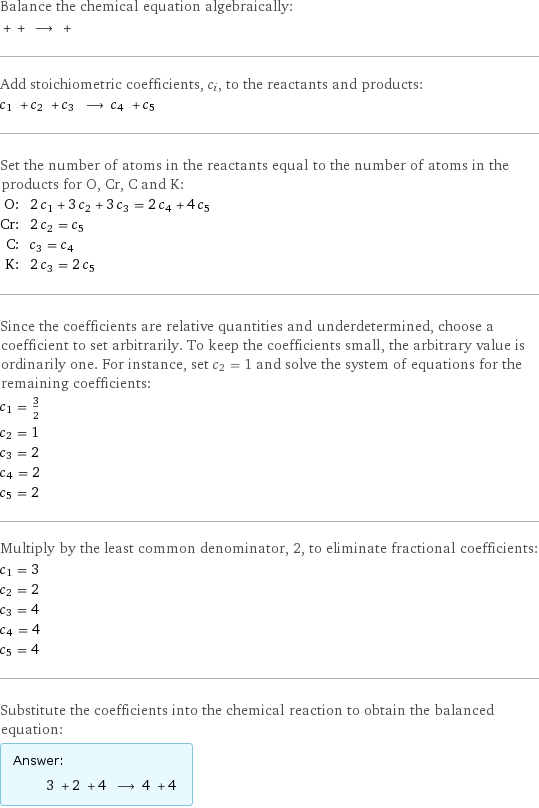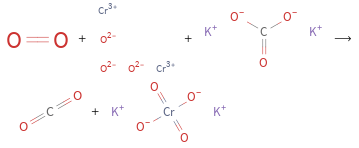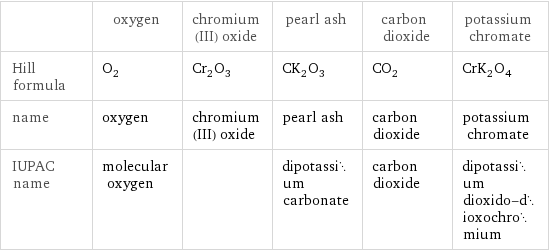Input interpretation

oxygen + chromium(III) oxide + pearl ash ⟶ carbon dioxide + potassium chromate
Balanced equation

Balance the chemical equation algebraically: + + ⟶ + Add stoichiometric coefficients, c_i, to the reactants and products: c_1 + c_2 + c_3 ⟶ c_4 + c_5 Set the number of atoms in the reactants equal to the number of atoms in the products for O, Cr, C and K: O: | 2 c_1 + 3 c_2 + 3 c_3 = 2 c_4 + 4 c_5 Cr: | 2 c_2 = c_5 C: | c_3 = c_4 K: | 2 c_3 = 2 c_5 Since the coefficients are relative quantities and underdetermined, choose a coefficient to set arbitrarily. To keep the coefficients small, the arbitrary value is ordinarily one. For instance, set c_2 = 1 and solve the system of equations for the remaining coefficients: c_1 = 3/2 c_2 = 1 c_3 = 2 c_4 = 2 c_5 = 2 Multiply by the least common denominator, 2, to eliminate fractional coefficients: c_1 = 3 c_2 = 2 c_3 = 4 c_4 = 4 c_5 = 4 Substitute the coefficients into the chemical reaction to obtain the balanced equation: Answer: | | 3 + 2 + 4 ⟶ 4 + 4
Structures

+ + ⟶ +
Names

oxygen + chromium(III) oxide + pearl ash ⟶ carbon dioxide + potassium chromate
Equilibrium constant
![K_c = ([CO2]^4 [K2CrO4]^4)/([O2]^3 [Cr2O3]^2 [K2CO3]^4)](../image_source/2c47f9fe1ca7fc110e414f2e5db78b37.png)
K_c = ([CO2]^4 [K2CrO4]^4)/([O2]^3 [Cr2O3]^2 [K2CO3]^4)
Rate of reaction
![rate = -1/3 (Δ[O2])/(Δt) = -1/2 (Δ[Cr2O3])/(Δt) = -1/4 (Δ[K2CO3])/(Δt) = 1/4 (Δ[CO2])/(Δt) = 1/4 (Δ[K2CrO4])/(Δt) (assuming constant volume and no accumulation of intermediates or side products)](../image_source/4decaf2a8541b4dbdb8a2da2350937de.png)
rate = -1/3 (Δ[O2])/(Δt) = -1/2 (Δ[Cr2O3])/(Δt) = -1/4 (Δ[K2CO3])/(Δt) = 1/4 (Δ[CO2])/(Δt) = 1/4 (Δ[K2CrO4])/(Δt) (assuming constant volume and no accumulation of intermediates or side products)
Chemical names and formulas

| oxygen | chromium(III) oxide | pearl ash | carbon dioxide | potassium chromate Hill formula | O_2 | Cr_2O_3 | CK_2O_3 | CO_2 | CrK_2O_4 name | oxygen | chromium(III) oxide | pearl ash | carbon dioxide | potassium chromate IUPAC name | molecular oxygen | | dipotassium carbonate | carbon dioxide | dipotassium dioxido-dioxochromium